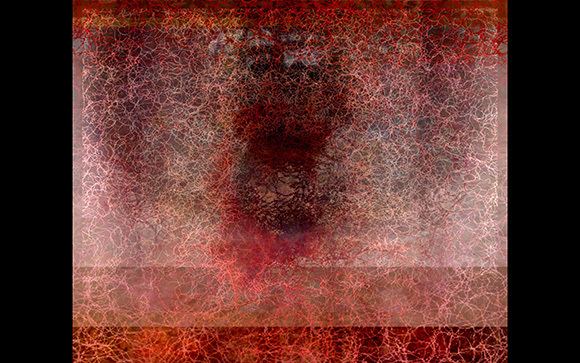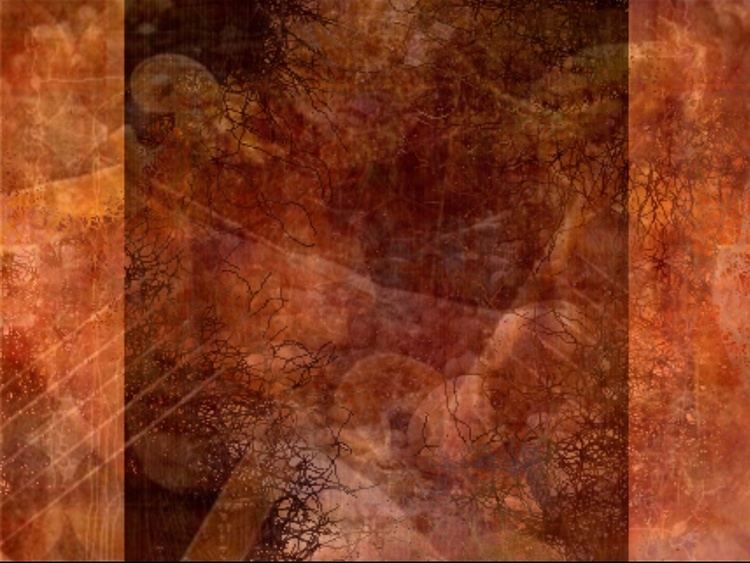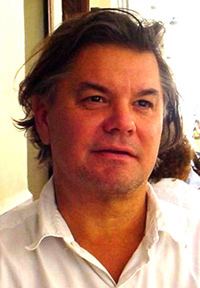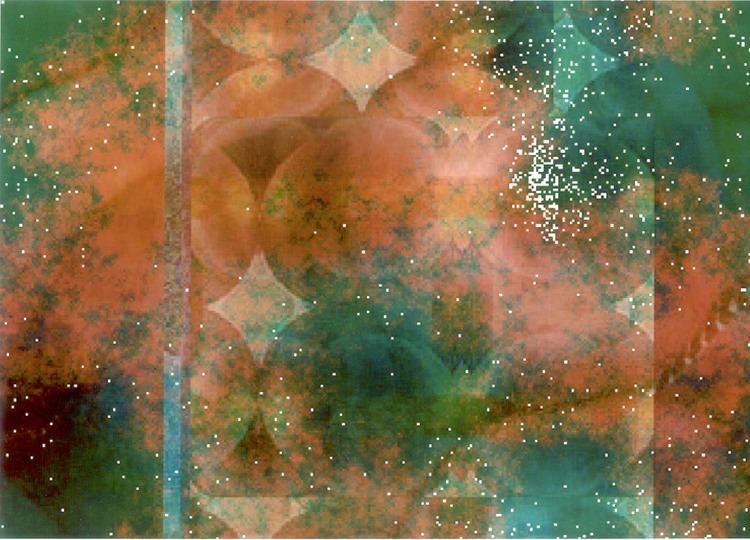Nationality American Known for Digital art, Sound art Period Conceptual art | Role Artist Name Joseph Nechvatal | |
 | ||
Books Towards an Immersive Intelligence: Essays on the Work of Art in the Age of Computer Technology and Virtual Reality 1993-2006 | ||
Joseph nechvatal s computer virus project 2 0
Joseph James Nechvatal (born 15 January 1951) is a post-conceptual digital artist and art theoretician who creates computer-assisted paintings and computer animations, often using custom-created computer viruses.
Contents
- Joseph nechvatal s computer virus project 2 0
- Joseph nechvatal interview
- Life and work
- Viractualism
- Cybism
- References

Joseph nechvatal interview
Life and work

Joseph Nechvatal was born in Chicago. He studied fine art and philosophy at Southern Illinois University Carbondale, Cornell University and Columbia University, where he studied with Arthur Danto while serving as the archivist to the minimalist composer La Monte Young. From 1979, he exhibited his work in New York City, primarily at Galerie Richard, Brooke Alexander Gallery and Universal Concepts Unlimited. He has also solo exhibited in Berlin, Paris, Chicago, Cologne, Atlanta, Los Angeles, Aalst, Belgium, Youngstown, Senouillac, Lund, Toulouse, Turin and Munich.

His work in the early 1980s chiefly consisted of postminimalist gray graphite drawings that were often photomechanically enlarged. During that period he was associated with the artist group Colab and helped establish the non-profit cultural space ABC No Rio. In 1983 he co-founded the avant-garde electronic art music audio project Tellus Audio Cassette Magazine. In 1984, Nechvatal began work on an opera called XS: The Opera Opus (1984-6) with the no wave musical composer Rhys Chatham.

He began using computers to make "paintings" in 1986 and later, in his signature work, began to employ computer viruses. These "collaborations" with viral systems positioned his work as an early contribution to what is increasingly referred to as a post-human aesthetic.
From 1991–1993 he was artist-in-residence at the Louis Pasteur Atelier in Arbois, France and at the Saline Royale/Ledoux Foundation's computer lab.There he worked on The Computer Virus Project, which was an artistic experiment with computer viruses and computer animation. He exhibited at Documenta 8 in 1987.
In 1999 Nechvatal obtained his Ph.D. in the philosophy of art and new technology concerning immersive virtual reality at Roy Ascott's Centre for Advanced Inquiry in the Interactive Arts (CAiiA), University of Wales College, Newport, UK (now the Planetary Collegium at the University of Plymouth). There he developed his concept of viractualism, a conceptual art idea that strives "to create an interface between the biological and the technological." According to Nechvatal, this is a new topological space.
In 2002 he extended his experimentation into viral artificial life through a collaboration with the programmer Stephane Sikora of music2eye in a work called the Computer Virus Project II, inspired by the a-life work of John Horton Conway (particularly Conway's Game of Life), by the general cellular automata work of John von Neumann, by the genetic programming algorithms of John Koza and the auto-destructive art of Gustav Metzger.
In 2005 he exhibited Computer Virus Project II works (digital paintings, digital prints, a digital audio installation and two live electronic virus-attack art installations) in a solo show called cOntaminatiOns at Château de Linardié in Senouillac, France. In 2006 Nechvatal received a retrospective exhibition entitled Contaminations at the Butler Institute of American Art's Beecher Center for Arts and Technology.
Dr. Nechvatal has also contributed to digital audio work with his noise music viral symphOny, a collaborative sound symphony created by using his computer virus software at the Institute for Electronic Arts at Alfred University. viral symphOny was presented as a part of nOise anusmOs in New York in 2012. In 2016, a limited edition CD recording of his sex farce poetry book Destroyer of Naivetés was released on Entr’acte label under the name of Cave Bacchus. Cave Bacchus is Nechvatal, Black Sifichi and Rhys Chatham.
In 2013, Nechvatal showed work in Noise, an official collateral show of the 55th Venice Biennale of Art, that was based on his book Immersion Into Noise.
From 1999 to 2013, Nechvatal taught art theories of immersive virtual reality and the viractual at the School of Visual Arts in New York City (SVA). A book of his collected essays entitled Towards an Immersive Intelligence: Essays on the Work of Art in the Age of Computer Technology and Virtual Reality (1993–2006) was published by Edgewise Press in 2009. Also in 2009, his book Immersive Ideals / Critical Distances was published. In 2011, his book Immersion Into Noise was published by Open Humanities Press in conjunction with the University of Michigan Library's Scholarly Publishing Office. In 2014 he published (as editor) a book and CD/cassette tape with Punctum Books and Punctum Records on the noise music artist Minóy and in 2015 he published with Punctum Books a collection of his farcical erotic poetry entitled Destroyer of Naivetés. Since 2013, Nechvatal has regularly been publishing his art criticism as the Paris correspondent for Hyperallergic blogazine.
Joe Lewis wrote:
Viractualism
Viractualism is an art theory term developed by Nechvatal in 1999. The term viractualism (and viractuality ) emerged from the Ph.D. research Nechvatal conducted in the philosophy of art and new technology concerning immersive virtual reality at Roy Ascott's Centre for Advanced Inquiry in the Interactive Arts (CAiiA), University of Wales College, Newport, UK (now the Planetary Collegium at the University of Plymouth). There he developed his concept of the viractual, which strives to create an interface between the biological and the virtual. It is central to Nechvatal’s work as an artist.
Nechvatal suggests that the term (concept) viractual (and viractualism or viractuality) may be an entrainment/égréore conception helpful in defining our now third-fused inter-spatiality which is forged from the meeting of the virtual and the actual. - a concept close to what the military call augmented reality, which is the use of transparent displays worn as see-through glasses on which computer data is projected and layered.
The basis of the viractual conception is that virtual producing computer technology has become a noteworthy means for making and understanding contemporary art and that this brings artists to a place where one finds the emerging of the computed (the virtual) with the uncomputed corporeal (the actual). This amalgamate - which tends to contradict some central techno clichés of our time - is what Nechvatal calls the viractual. Digitization is a key metaphor for viractuality in the sense that it is the elementary translating procedure today. Nechvatal thinks that in every era the attempt must be made anew to wrest the art practice away from conformisms that are about to overcome it.
Cybism
Cybism is an art theory term developed by Nechvatal as a sub-division of viractuality following discussion with artist Kenneth Wahl at the turn of the century. Wahl preferred the term scybism. The concept was proposed by Nechvatal for an exhibition in 2003 called The Attractions of Cybism for Fairfield University that never was realized.
As defined by Dr. Nechvatal, Cybism is a new sensibility emerging in art respecting the integration of certain aspects of science, technology and consciousness – a consciousness struggling to attend to the prevailing current spirit of our age. This cybistic zeitgeist Nechvatal identifies as being precisely a quality-of-life desire in which everything, everywhere, all at once is connected in a rhizomatic web of communication. Therefore, cybism is no longer content with the regurgitation of standardized repertoires. Rather Nechvatal detects in art a fertile attraction towards the abstractions of advanced scientific discovery - discovery now stripped of its fundamentally reductive logical methodology.
Nechvatal states that cybism can be used to characterize a certain group of researchers and their understanding of where cultural space is developing today. Cybists reflect on system dynamics with a hybrid blending (cybridization) of the computational supplied virtual with the analog. This blending of the computational virtual with the analog indicates the subsequent emergence of a new cybrid topological cognitive-vision that Nechvatal has called viractuality: the space of connection betwixt the computed virtual and the uncomputed corporeal (actual) world which merge in cybism.
Nechvatal states that co-extensive notions found in cybism have sharp ramifications for art as product in that the cybists are actively exploring the frontiers of science/technology research so as to become culturally aware of the biases of consciousness in order to amend those biases through the monumentality and permanency which can be found in powerful art. He begins with the realization that every new technology disrupts the previous rhythms of consciousness. In this sense cybist art research begins where hard science/technology ends.
